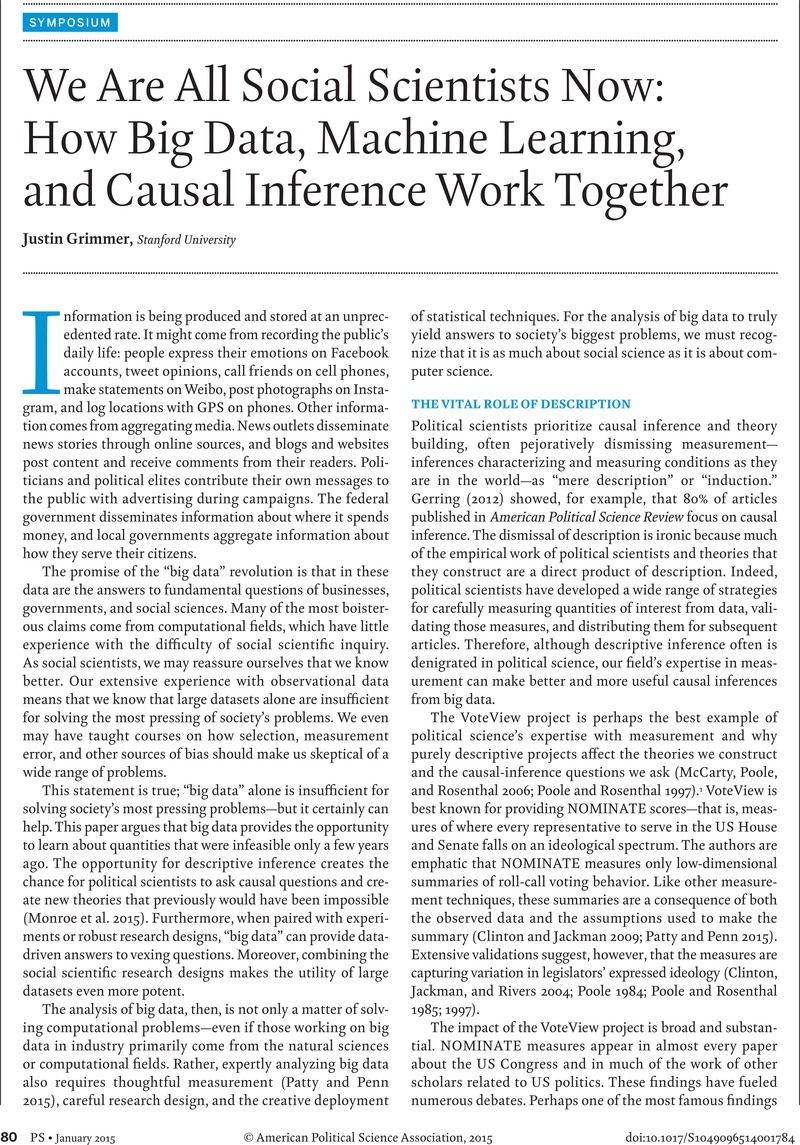Crossref Citations
This article has been cited by the following publications. This list is generated based on data provided by Crossref.
Zambom Santana, Luiz Henrique
dos Santos Mello, Ronaldo
and
Roisenberg, Mauro
2015.
Smart Crawler.
p.
125.
Peysakhovich, Alexander
and
Naecker, Jeffrey
2015.
Machine Learning and Behavioral Economics: Evaluating Models of Choice Under Risk and Ambiguity.
SSRN Electronic Journal,
Hagen, Loni
Harrison, Teresa M.
Uzuner, Özlem
Fake, Tim
Lamanna, Dan
and
Kotfila, Christopher
2015.
Introducing textual analysis tools for policy informatics.
p.
10.
Grubert, Emily
and
Siders, Anne
2016.
Benefits and applications of interdisciplinary digital tools for environmental meta-reviews and analyses.
Environmental Research Letters,
Vol. 11,
Issue. 9,
p.
093001.
Fraire, Mary
Spagnuolo, Sabrina
and
Stasi, Serenella
2016.
L'utilizzo dei big social data per la ricerca sociale: il caso della cittadinanza attiva in difesa del territorio.
SOCIOLOGIA E RICERCA SOCIALE,
p.
174.
Maciejewski, Ross
and
Montgomery, Douglas C.
2016.
Visualization for Data Science: Adding Credibility, Legitimacy, and Saliency.
Big Data,
Vol. 4,
Issue. 2,
p.
73.
Nieminen, Hannu
2016.
Digital divide and beyond: What do we know of Information and Communications Technology’s long-term social effects? Some uncomfortable questions.
European Journal of Communication,
Vol. 31,
Issue. 1,
p.
19.
London, Jennifer A.
2016.
Re-imagining the Cambridge School in the Age of Digital Humanities.
Annual Review of Political Science,
Vol. 19,
Issue. 1,
p.
351.
Bauer, Paul C.
2017.
Visualizing Causal Scenarios [Interactively].
SSRN Electronic Journal ,
Katz, Gabriel
and
Levin, Ines
2017.
Varieties of Political Support in Emerging Democracies: A Cross-National Analysis.
SSRN Electronic Journal,
Laaksonen, Salla-Maaria
Nelimarkka, Matti
Tuokko, Mari
Marttila, Mari
Kekkonen, Arto
and
Villi, Mikko
2017.
Working the fields of big data: Using big-data-augmented online ethnography to study candidate–candidate interaction at election time.
Journal of Information Technology & Politics,
Vol. 14,
Issue. 2,
p.
110.
Dourado, Aloisio
Carvalho, Rommel N.
and
van Erven, Gustavo C. G.
2017.
Brazil's Bolsa Familia and young adult workers: A parallel RDD approach to large datasets.
p.
17.
Yang, Chaowei
Huang, Qunying
Li, Zhenlong
Liu, Kai
and
Hu, Fei
2017.
Big Data and cloud computing: innovation opportunities and challenges.
International Journal of Digital Earth,
Vol. 10,
Issue. 1,
p.
13.
Possamai-Inesedy, Alphia
and
Nixon, Alan
2017.
A place to stand: Digital sociology and the Archimedean effect.
Journal of Sociology,
Vol. 53,
Issue. 4,
p.
865.
Creamer, Germán G.
Ghoddusi, Hamed
and
Rafizadeh, Nima
2018.
Machine Learning in Energy Economics and Finance: A Review.
SSRN Electronic Journal ,
Comarela, Giovanni
Durairajan, Ramakrishnan
Barford, Paul
Christenson, Dino
and
Crovella, Mark
2018.
Assessing Candidate Preference through Web Browsing History.
p.
158.
Harsh, Rajeshwari
Acharya, Gaurav
and
Chaudhary, Sunita
2018.
Big Data Hysteria, Cognizance and Scope.
p.
1.
Brantly, Aaron F.
2018.
When everything becomes intelligence: machine learning and the connected world.
Intelligence and National Security,
Vol. 33,
Issue. 4,
p.
562.
Mijares, Víctor M.
2018.
Performance of the South American Defense Council Under Autonomy Pressures.
Latin American Policy,
Vol. 9,
Issue. 2,
p.
258.
Katz, Gabriel
and
Levin, Ines
2018.
Varieties of political support in emerging democracies: A cross-national analysis.
Social Science Research,
Vol. 70,
Issue. ,
p.
55.



